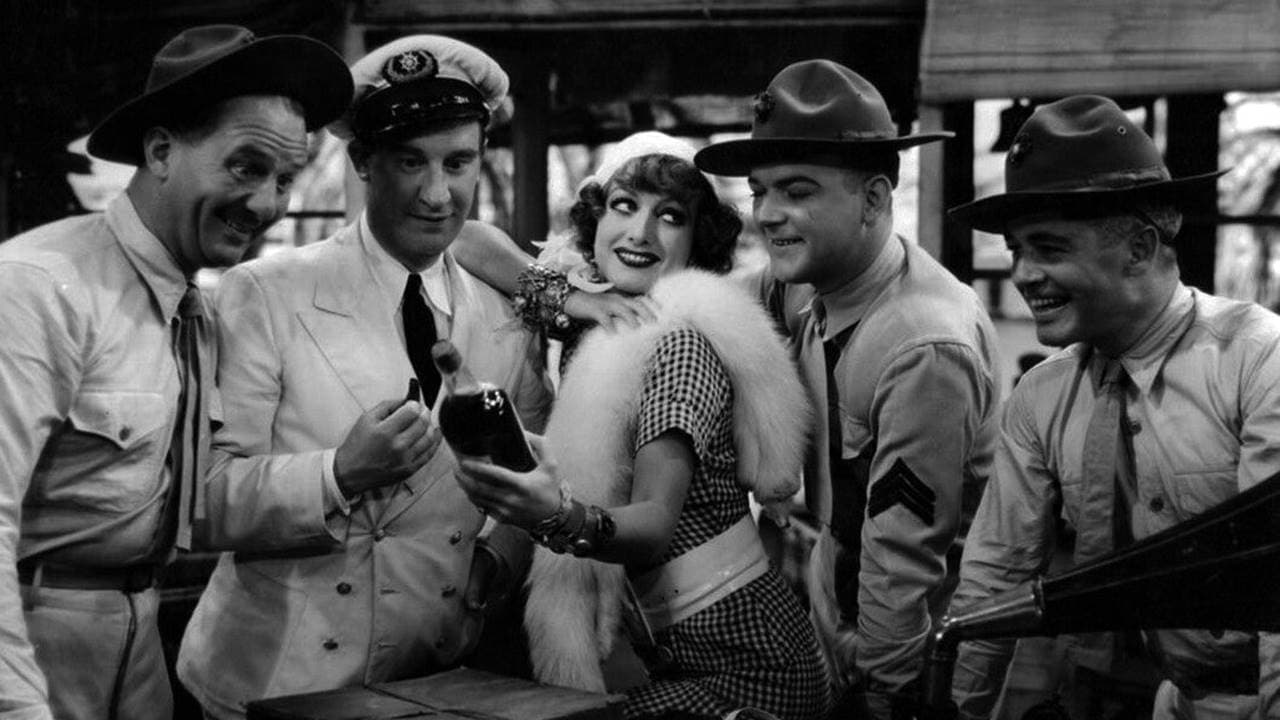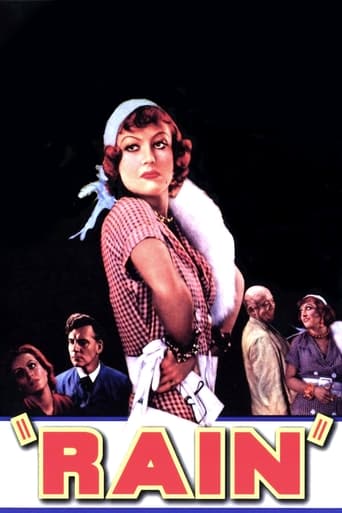



Strong and Moving!
Some things I liked some I did not.
brilliant actors, brilliant editing
How wonderful it is to see this fine actress carry a film and carry it so beautifully.
View MoreDespite it's age and accompanying stagey direction this is still a very powerful film. The story works on various levels and having now seen this adaption I want to read the book for any nuances not transferred to the film.Yet, however good the story, it is Joan Crawford's performance that makes the screen version so watchable. She attracts and enthrals from the beginning (the snappy dialogue assists with this). She plays Sadie Thompson as flirty, sexy, sassy but also weak and vulnerable and does so in all the right places, at the right time, and in the right proportions. Walter Huston is also a large presence in the film and although these two main performances cast a large shadow which the lesser players struggle to find any light in which to illuminate their own character depictions it is still a very good film and outstanding for it's time.
View MoreJoan Crawford Hated this one, most Likely because it Bombed at the Box Office and got some Bad Reviews. But it Speaks for Itself. Predictably Talky, but not without some Effective and sometimes Impressive Visuals. From a Painted Up and Garishly Decorated Tainted "Lady of the Night" (Sexy Sadie) to some Fluid Camera-Work for the Time, and an Atmosphere Drenched in God's Nectar, the Movie is a Pre-Code Sermon on Religious Hypocrisy with a Plea for a "Live and Let Live" Society. Walter Huston gives an Acerbic Stiff Performance. But at Their Worst, these Types of Bible-Thumpers are Acerbic, although some can be Charming and Suave. There's an Added Treat of the Inn Keeper Reciting Friedrich Nietzsche (the "God is Dead" Philosopher).Overall, it is Definitely Worth a Watch for Joan Crawford's Iconic Entrance and overall Look and Her sometimes Effective and sometimes Not so Effective Performance, the Direction of Lewis Milestone, and the Pre-Code Freedom to Take On the Subject of Religion that would become a Blasphemous NO NO in the Post Code Years.Reformers were Successful in Bringing about Prohibition and were also Highly Influential in Establishing the Motion Picture Production Code.Right Wing Religious Evangelicals were as Powerful in the Twenties and Thirties as They are Today and Have and Had a Heavy Hand in Directing Political Figures. The Breen Office and Hays Code would Silence the Artistic Opposition on Screen for Decades.
View MoreThere's a time in the early 1930s when almost primitive movie-making suddenly became more modern. It isn't a date...depending on the studio and the director, it seems to fluctuate between 1932 (when this film was made) and about 1936. Regardless, the production values here border on being rather primitive. So that's one black mark (or perhaps -- considering the main character -- I should say red mark) on my score card to begin with.And then there's Joan Crawford's characterization of Sadie Thompson. If the old adage of less is more...well, let's just say that director Lewis Milestone overdid it in regard to making us aware that Thompson was a loose woman. It wasn't so much that Crawford overacted, as much as the makeup people and costumer overdid the stereotype. And lest you think I'm just having a wrong perception because I'm watching the film in 2013, at the time of its release, "Variety" said: "Joan Crawford's get-up as the light lady is extremely bizarre. Pavement pounders don't quite trick themselves up as fantastically as all that." It is said this was Crawford's least favorite film, although it's unclear whether that was due to her role or the fact that it bombed at the box office. After her temporary reformation, the acting -- and the look -- is more realistic.Another thing I have against this film is the acting of Beulah Bondi. Bondi is one of my all-time favorite character actresses, but here she is so wooden and stereotyped as the role of the minister's wife.I feel the same about the acting of Walter Huston here. Wooden in both movement and speech. And yet, just four years later I felt he was magnificent in "Dodsworth".Matt Moore was fine as the doctor, and Guy Kibbee did nicely as the hotel owner.My criticism is not to say there were no high points. Some of the dialog is actually quite well written...just not performed realistically. And, for 1932, Milestone used some interesting camera angles.But overall, my opinion of this film is rather negative, and I guess we must blame the director/producer Lewis Milestone. Ironically, Milestone was a 4-time Oscar nominee, and took 2 Oscars home. Clearly his output was inconsistent.Oh, and by the way, having lived in the tropics for 2 years...they overdid it with the deluge of rain.
View MoreIt's hard not to see Rain as the film that symbolizes the pre-code era, where Hollywood was not afraid to portray the more libertine side of society, and give an image that was not so morally right. And it's also hard not to see this film as a direct protest against the code that there was talk about during these years. The Hays Code sought to make films more caste. And the plot of this film makes too much a got metaphor for the whole situation.Joan Crowford plays a prostitute that is accused for her behavior by Puritans in some lost Hawaiian island. Among them is Mr. Davidson, a powerful man who has an obsession with religion. In reality, Joan Crowford is playing herself and the image we all have of her. And in fact, the way she enters the screen dressed all too flamboyantly like a hooker is a penchant, as much as it is too cheesy for an audience that doesn't understand that at that time, that was the Hollywood idea of a real woman.However you decide to view it, it's a hard watch. Not so much as the flow of the viewing itself (although it does tend to be slow), but for other flaws. In the plot, we are not given any character to side with. Supposedly, the main characters are Sadie (Joad Crawford) and Mr. Thompson (Walter Huston). However, they are also the extreme, and both obnoxious. Sadie is a flirty skank, and an actress, playing with other people's feelings. And Thompson, her enemy in the story, is just too mad for us to side with him. So, really, the only character we can side with, and can actually identify with is Tim O'Hara (William Gargan). That gives the audience a limited participation.And even then, Handsome is too innocent. When he first sees Sadie, he is mesmerized, almost unable to speak. He is, in fact, the personification of the ordinary man seeing the Hollywood star Joan Crawford in the real world. He falls in love with her right away. We, as the audience, can't help feeling that she is playing him, using him because she knows that he will be helpful, and because she needs friends. Handsome falls in love with her completely and can't reason right from wrong. Yet, we can't blame his innocence. He represents the audience: Crawford is the star, she is the one that gets the best close-ups, hence, we have to love her. Mr. Davidson is the bad one.The metaphor, as far as the Hays code connection lies, is in that Crawford represents cinema, and Huston represents the puritanism. The film never quite picks sides, nor do we. But they are obviously both horrible. It's as if the film were stating that Hollywood needs to pull the breaks a little, but still not give in entirely to the Puritan demands.The film is taken from a Broadway production. Perhaps director Lewis Milestone wasn't aware that he wasn't making a stage production, because although the style resembles many of the time, here he even has the actors exiting what looks like a theatrical set, all the times. Supposedly, he is not all to blame, Maxwell Anderson, in charge of the adaptation, wrote it so that the film had to be just that. But it's frustrating to see that the camera is moved quite well in some sequences, and then the setting comes across as so unreal.The mise-en-scene itself cannot be judged negatively. In he scenes in which Sadie and Mr. Davidson are together, the camera looks at him from below, and Sadie seems to be always placed lower than him. This shows the authority that he holds. In the scene when he starts reciting the Our Father, he is higher up on the stairs, and when Sadie kneels down at the bottom of the stairs and begins praying, it looks like she is praying at him.Yet, the story itself is disappointing. The fact that we cannot side with any of the characters makes it so that we don't really care about what is going on, and if we do, we tend to change our minds quite quickly. In the end, we are almost completely let down, by the fact that the message seems to be that morality never wins. But after all, we don't know what morality is.The acting is brilliant. Joan Crawford has an easy part; she's playing herself. William Huston is a revelation. He is quite extraordinary as well as eccentric, he seems to dominate every scene he is in. We almost come to admire his character, and side with him, although he is insane.The final line is the one where Crawford says she is sorry for everyone in the world. Is that a sly comment on the cinema that was about to come? Or should we see it as an apology for such a mediocre film, only good as a vehicle for Crawford's on-screen persona?
View More